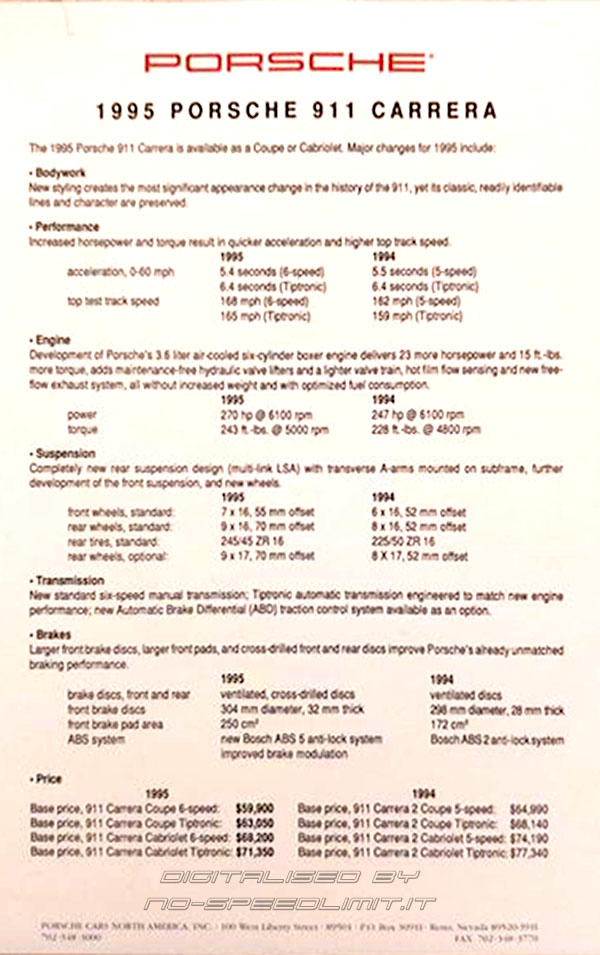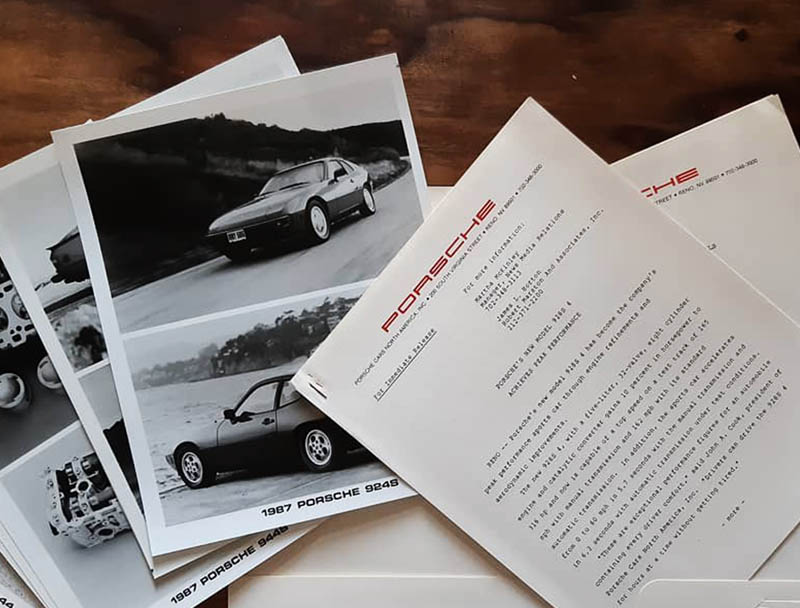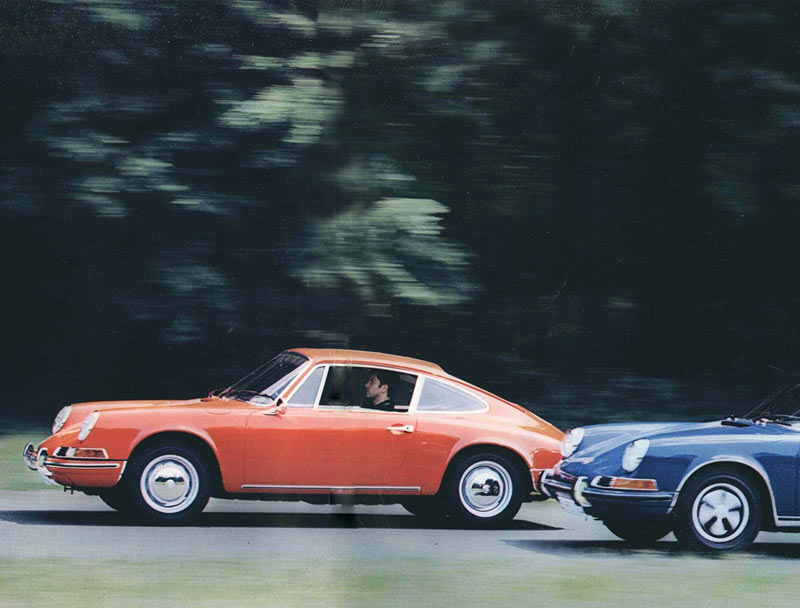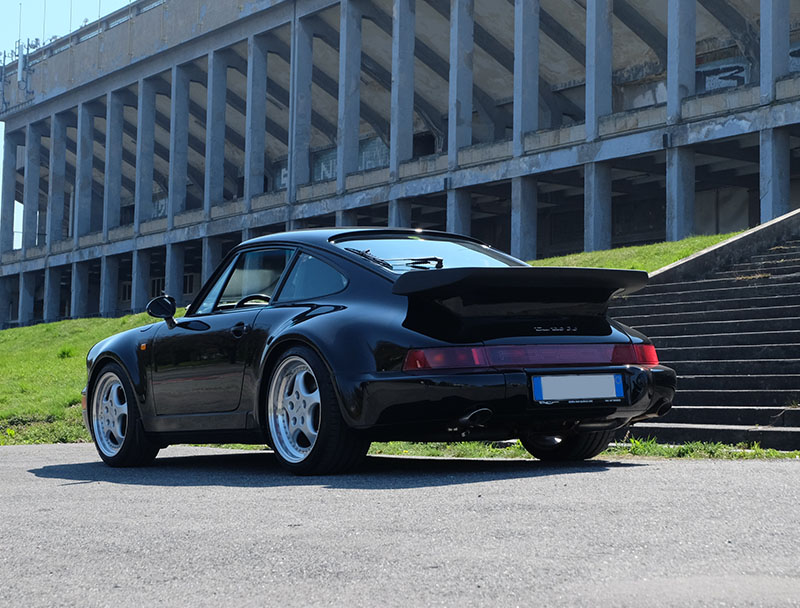.jpg)
1994 Porsche 911 UK
This is a preview of the 1995 model included in the press kit distributed at Chicago Motor Show in January 1994.
.jpg)
The 1995 Porsche 911 Carrera represents the most sweeping body of changes ever carried out on a car which, more than any other, has defined the sports car and GT concept for the past thirty years.
Major changes for 1995 include:
New styling creates the most significant appearance change in the history of the 911, yet its classic, readily identifiable lines and character are preserved
Development of Porsche's 3.6 liter air-cooled six-cylinder boxer engine delivers more horsepower and torque, adds maintenance-free hydraulic valve lifters, hot film flow sensing and new free-flow exhaust system, all without increased weight and with optimized fuel consumption
New standard six-speed manual transmission; Tiptronic automatic transmission engineered to match new engine performance
Completely new rear suspension design (multi-link LSA) with transverse A-arms mounted on subframe, further development of the front suspension, and new wheels
Larger front brake discs, larger front pads, and cross-drilled front and rear discs improve Porsche's already unmatched braking performance
Increased horsepower and torque result in quicker acceleration and higher top track speed
Driver and front passenger airbags have been improved, the windshield wipers cover more ofthe windshield providing a greater area with double coverage forbetter cleaning and new modular ellipsoid headlights produce greater light output
Occupant comfort is enhanced by new ventilation system particle filters and redesigned seats
Exterior noise levels are reduced, and environmentally friendly water-based paints are used for all metallic colors
An automatic wind blocker, for more comfortable open-air driving, is available as an option on the Cabriolet, which offers 2+2 seating and new 3-point rear safety belts
The Porsche 911 created a sensation when it was frst shown atthe Frankfurt Auto Show in September, 1963. In the intervening thirty years, the body shape drawn by Ferdinand Alexander Porsche has become a classic, instantly recognizable throughout the world as a timeless example of automobile engineering and styling. More than 350,000 enthusiastic buyers have chosen the Porsche 911. The 911 in all its forms has made its mark in the public eye, on roads and on race tracks as the quintessential Porsche
That a styling concept can remain accepted by the public for more than thirty years is almost unthinkable in the automotive world, where five-year product cycles are the norm and many car designs age noticeably in only a year or two. Through continuous intensive development, Porsche has been able to keep the landmark design of the 911 as exciting as when it was first drawn.
But after thirty years, even a versatile concept such as the 911 reaches the edges of its development envelope. Lean production methods are becoming essential today, and new governmental regulations become more difficult to meet with existing designs. Thus Porsche has taken the inevitable step and developed an all-new successor to the venerable 911: the 1995 Porsche 911 Carrera. The next-generation Porsche combines the best of the old model with fresh styling and the latest advances in automotive engineering.
The styling and engineering teams had a number of goals to meet in designing the new 911:
.jpg)
The 1995 Porsche 911 Carrera retains the proven Porsche layout, with its rear-mounted horizontally-opposed air-cooled engine and 2+2 seating, and is available as a Coupe or Cabriolet. The 1995 911 Carrera is wider and has greater front and rear track than its 1994 counterpart. Curb weight is only 33 lbs. greater for the manual version, and 23 lbs. greater for the Tiptronic.
The overall design of the 1995 Porsche 911 remains the same: a fully galvanized steel unit body incorporating an integral box-section frame, with bolted-on front fenders. Compared to its already remarkably rigid predecessor, torsional stiffness has been increased an additional 20 percent without added weight (the weight of the basic chassis is unchanged).
Doors have been extensively reworked, with altered interior releases and restyled exterior handles. Side impact beams, which already meet 1997 standards, are made of steel with a yield strength of 61,000 psi, 56% higher than the previous Porsche 911.
.jpg)
The 1995 Porsche 911 Carrera equals or exceeds its predecessor in all performance aspects. Acceleration to 60 mph for the manual transmission 911 Carrera is quicker, and top track speed is 6 mph higher for both manual and Tiptronic-equipped cars. Performance of the 1995 Porsche 911 Carrera Cabriolet matches that of the Coupe
The new rear suspension design and improved front: suspension provide better cornering performance. Depending on the pavement, the 1995 Carrera will exceed 1.0 g of lateral acceleration.
Cross-driled front and rear brake discs, and larger front discs and pads, ensure that for 1995, the industry-leading braking performance of the Porsche 911 Carrera is improved yet again.
Performance overview
| 1995 | 1994 | |||
| 6-speed | Tiptronic | 5-speed | Tiptronic | |
| 0-60 mph | 5.4 sec. | 6.4 sec. | 5.5 sec. | 6.4 sec. |
| standing start 1/4 mile | 13.9 sec. | 14.5 sec. | 13.9 sec. | 14.5 sec |
| top test track speed | 168 mph | 165 mph | 162 mph | 159 mph |
(Performance data is provided for comparison purposes only. Porsche recommends obeying all speed laws.)
.jpg)
The 1995 Porsche 911 Carrera incorporates a complete exterior reshaping. Lines are more flowing and rounded, yet the design remains immediately recognizable from any angle as Porsche's classic 2+2 sports car.
New exterior features include:
A key appearance feature of the 911 has always been its front aspect, with characteristic backswept headlights marking the forward edge of its rounded fenders The 1995 911 Carrera caries that classic Porsche theme, with a flowing, more streamlined appearance, The headight combination of poly-ellisoid (PES) low beams and variable focus (VF) high beams provides higher light output than the previous arrangement. By actuating a lever inside the trunk, the light units swing out for easy bulb replacement without any tools.
Careful attention to cooling airflow resulted in downward-facing air vents ahead of the front wheels. Air flows in through the nose, through the engine oil cooler and air conditioning condenser, and exits ahead of the front wheels to act as an invisible spoiler. Most cars would return lower drag figures with all airinlets closed; the new 911 Carrera is one of the few cars that actually has lower aerodynamic drag with cooling airflow than without. The underside of the 1995 Porsche 911 Carrera is enclosed by underbody panels which shroud the front and center of the underbody, suspension and engine. The underbody sheathing employs ground effectto reduce vehicle lift. The drag coeficient (cd) of the 1995 Porsche 911 Carrera is 0.33.
At the rear, the 911 Carrera continues to carry Porsche's electrically-extendable rear spoiler, which provides added downforce for increased stability at high speeds as well as additional engine-cooling air. The rear spoiler of the 1995 Porsche 911 Carrera is larger, and its rear lip has been reshaped At rest, the spoiler retracts to exhibit the flowing lines of Porsche's to classic sports car shape to best advantage.
The windshield is trimmed with a new flush-mount rubber gasket. Side and rear glass is also mounted flush. These measures contribute to reduced interior noise as well as improved aerodynamics. Redesigned door seals improve noise levels and allow the doors to latch easily.
Windshield wiper geometry has also been modified. The wiper arm pivots are now located side-by-side, near the vehicle centerline, allowing the paths of the two wiper blades to overlap. The result is improved vision, with 80 percent of the swept area receiving double coverage.
.jpg)
The 1995 Porsche 911 Carrera is available in Coupe or Cabriolet form, and features a number of advances and improvements over its predecessors.
A newly designed rear seat occupant restraint system, based on a shoulder harness support mechanism between the rear seats, once again allows Porsche owners to enijoy the Cabriolet as a true 2+2 sports car. An innovative steel structure serves as the upper anchor point for the three-point rear safety belts. This component is cushioned with foam and covered in leather or leatherette matching the interior. The rear seatbacks have also been reshaped.
With the 1995 Porsche 911 Carrera Cabriolet, Porsche willoffer a unique feature exclusive to this model: a fully automatic wind blocker. This factory or dealer installed option is the first device of its kind to raise automatically when the top is opened, and stow automatically when the top is closed. The wind blocker, which reduces buffeting and turbulence, consists of an aluminum frame covered with a cloth mesh, With the top open, it raises behind the front seats and encloses the rear seat area with an automatically extended cloth cover. With the top closed, the wind blocker folds against the headliner, providing nearly the same headroom as the Coupe. The wind blocker may be stored in a horizontal position in the rear seat area by manually releasing a locking mechanism. It can also be removed and stowed in the front trunk to allow use of the Cabriolet as an open car with three or four persons aboard.
With its new double-acting top sealing system, the 1995 Porsche 911 Cabriolet once again sets new standards for convertibles. If an unusually large amount of water, such as from a powerful car wash system, cannot be sealed out by the outer rubber lip of the convertible top. catch spaces are integrated in the rubber seal to drain away the excess volume through the door seals of the A-pillars. Integration of other sealing components into single-piece units permits further optimization of interior sealing.
The 1995 Porsche 911 Carrera's fully automatic electric top mechanism, which will open or close the roof in approximately 13 seconds, is largely unchanged from the previous generation. Operation of the power top has been modified, allowing the driver to open or close it while the engine is running. The car must be stationary and the parking brake engaged.
The interior of the new 911 Carrera Cabriolet has been made more attractive, with the entire top mechanism covered by a new headliner. The headliner material provides especially good sound insulating qualities, and folds smoothly and easily when the top is retracted.
The rear window of the 1995 Porsche 911 Carrera Cabriolet is bonded to the convertible top with hot glue, alowing it to be replaced more quickly and easily, In the past, if this plastic window was scratched or damaged, the entire top had to be removed in order to sew in the replacement window.
The same exciting lines of the new 1995 Porsche 911 Carrera Coupe are found in the Cabriolet version. The main top bow and the top frame have been redesigned for a more rounded appearance.
.jpg)
Although the basic cockpit remains unchanged, several interior details received further development for improved functionality and ergonomics:
The powerplant of the 1995 911 Carrera is a further refined and developed version of the 911 3.6 liter engine. Design goals for the 1995 911 Carrera engine included increased power, optimized fuel consumption, improved serviceability and reduced manufacturing costs.
These goals were met through an extensive program of engineering changes, including:
As a result of these technical refinements, substantial power and torque increases were realized for the engine of the 1995 Porsche 911 Carrera:
| 1995 | 1994 | |
| power | 270 hp @ 6100 rpm | 247 hp @ 6100 rpm |
| torque | 243 ft. lbs. @ 5000 rpm | 228 ft. lbs. @ 4800 rpm |
The 1995 Porsche 911 Carrera is powered by a 3.6 liter engine with a compression ratio of 11.3:1, and cylinder bore and stroke dimensions of 100 mm x 76.4 mm. These dry numbers give little evidence of the extensive internal modifications carried out on Porsche's time: honored horizontally-opposed six cylinder engine concept. The valvetrain now features hydraulic valve lifters in the tips of the rocker arms, which completely eliminate the need for periodic valve adjustment, reduce engine noise and also provide improved cold start emissions.
The exhaust system has been extensively redesigned to meet two apparently conflicting goals: lower backpressure and reduced noise. Lower backpressure allows higher engine output, but typically increases noise. By careful acoustic design, Porsche is able to meet both requirements.
The design goal of decreasing noise while maintaining the characteristic Porsche sound so enjoyed by enthusiasts is furthered by the hydraulic lifters which elimninate valve train noise, the stiffer crankshaft which reduces resonance effects, and the lighter pistons and connecting rods which reduce noise associated with mechanical play. The engine underbody further reduces noise radiation.
The 1995 Porsche 911 Carrera may be ordered with a six-speed manual transmission or Porsche's unique Tiptronic automatic transmission.
Engine development of the 1995 Porsche 911 Carrera led to extensive transmission changes, including:
The six speed transmission permits the driver to select a gear that allows the engine to provide maximum acceleration or low revolutions for cruising, as appropriate. A further benefit is improved fuel economy. The 1995 Porsche 911 Carrera reaches top speed in sixth gear; unlike many cars with extremely long overdrive transmissions, itis not necessary to shift down to fifth to experience the top speed of the 911 Carrera. The six speed gearbox allowed Porsche engineers to lower the gearing in fourth and fifth gears, resulting in better throtle response athigher speeds. First and second gears of the new six-speed transmission now employ dual-cone synchronizers. These reduce shift forces by 30 to 40 percent.
Porsche's unique Tiptronic transmission, one of the most sophisticated automatic transmissions presently available, has also received further development for the 1995 model year, specifically:
To match the Tiptronic to the more powerful engine, shit points and shift strategies were remapped for improved comtort, optimized fuel economy and better performance as wll as reduced noise and exhaust emissions. Compared to the 1994 model, the 1995 Tiptronic spends a greater proportion of its time with the torque converter clutch locked. When driving on hilly roads, driving share of the lower gears was increased to provide better acceleration and engine braking effect. A new feature for 1995 is the ability to trigger downshits in automatic mode by braking, ensuring that the proper gear is available for subsequent cornering.
As an option, Porsche offers a limited slip differential with its exclusive ABD (Automatic Brake Differential) traction system. ABD works as an extension of the ABS 5 brake system. When a rear wheel spins under acceleration, the control system automatically applies the brakes at only that wheel. This enables the maximum possible engine torque to be transmitted, and makes it easier to start from standstill under slippery conditions. Above 44 mph, the system becomes inactive. ABD activation is communicated to the driver by an indicator light on the dash. On six-speed cars, the optional limited slip differential includes Porsche's ABD traction system with lockup. For Tiptronic-equipped 911 Carreras, the ABD traction systemn without lockup is available as an option.
The 1995 Porsche 911 Carrera employs a new, completely redesigned rear suspension and further development of the front suspension. At the rear, the semi-trailing arms and struts have been replaced by Porsche's new multi-link LSA suspension (Lightweight-Stable Agile). This is the first ever use of a subframe-mounted design on a rear-engined production automobile.
The new rear suspension includes:
The rear axle consists of a subframe carrying upper and lower A-arms, with additional lower transverse links. The A-arms are actually formed of two separate upper links and single-piece lower arms on each side. These suspension members are designed to be loaded mainly in tension and compression, which permits lighter design than it they also had to carry bending forces. The lower transverse links are designed to control toe-in under both longitudinal and cornering forces.
The rear suspension kinematics are a further development of the "Weissach" suspension pioneered on the Porsche 928. Under cornering forces, the outside rear wheel toes in to reduce oversteering tendencies. Handling remains stable regardless of side force, and the car tracks precisely even under high cornering forces or rapid lane changes. Rear toe in also changes in response to braking, ensuring good directional stability. The new suspension permits lateral acceleration figures in excess of 1.0 g on high-traction surfaces, and 5% higher slalom speeds than the 1994 model - significant improvements.
Primary goals for tront suspension development were improved stability on smooth as wll as uneven surfaces, and enhanced braking performance in situations where one side of the car experiences more grip than the other, such as when one side is on gravel.
Benefits of the front suspension modifications are:
Porsche's sport suspension is available as an option on the 911 Carrera Coupe. Changes compared to the standard suspension include:
The 1995 911 Carrera continues Porsche's tradition of offering brakes that are among the best in the industry. In keeping with the greater performance potential of the 1995 911 Carrera, the brake system received extensive revision.
New features for 1995 include
For 1995, the front rotors increase in outside diameter from the previous 298 mm to 304 mm. Front rotor thickness increases from 28 to 32 mm. Larger four-piston fixed calipers are installed at the front, with 45% greater pad area. At the rear, the brake rotor size remains unchanged at 299 mm but front and rear rotors are now cross-drilled for improved cooling and quicker response in wet conditions.
The brake system uses the latest ABS 5 three-channel anti-lock system. ABS 5 provides several advantages over earlier systems:
In addition, ABS 5 provides redundant control systems and builtin diagnostic functions. For service purposes, the ABS 5 system retains a failure memory, allows real-time diagnostic monitoring during driving, and permits individual brake actuators to be addressed by service personnel.
The 16-inch diameter standard wheels of the 1995 Porsche 911 Carrera are an inch wider, front and rear, than in 1994. Standard rear tires are also wider. The optional 17-inch wheel and tire package for 1995 has wider rear wheels than the previous model, but retains the same tire sizes as in 1994. Thanks to the new rear axle design, rolling noise and tire wear are decreased without requiring any changes in tire design.
At Porsche, safety begins with a car's driving characteristics. The dynamic behavior of Porsche sports cars is the result of advanced testing and experimentation, as well as experience on the race track. The results are uncompromising design of suspension, steering, and brakes. Safety considerations are also reflected in the comfort, excellent visibility, and ergonomically correct design of Porsche sports cars.
Safety is not a new concept at Porsche. Since 1973, every Porsche 911 has been equipped with door reinforcements for increased protection in side impacts. In 1990, Porsche was the first auto manufacturer to equip all of its products with anti-lock brakes. Also in 1990, Porsche was the first manufacturer, domestic or import, to equip every car sold in the United States with driver as well as front passenger airbags as standard equipment.
The 1995 Porsche 911 Carrera includes several improvements to the airbag system:
In addition to these changes in the passive restraint system, the 1995 Porsche 911 Carrera Coupe and Cabriolet provide three-point safety belts for both front and rear seat passengers.
Airbags and safety belts represent just one level of protection for the occupants, however. The car's structure is also designed for safety, with a rigid cage to surround the occupants and deformable crush zones to absorb impacts. Porsche was the first manufacturer to build car bodies using sheet steel galvanized on both sides. This not only preserves the appearance of the car and the owner's investment, but also maintains the built-in crashworthiness of the car. Porsche is one of only two manufacturers who feels so strongly about its corrosion protection measures that it provides a fullten-year limited warranty against rust perforation. Even the paint carries a three-year limited warranty.
Porsche is not only pioneer in high technology and high performance, but an industry leader in environmental responsibility. This begins with building cars to last. Of all the Porsches built since 1948, it is estimated that 80 percent are still in service. Part of that longevity comes from the fully galvanized bodywork of the Porsche 911. Its durability has been a factor in maintaining Porsche's traditionally high resale values and unparalleled owner loyalty.
During development of the 1995 91 1 Carrera, the goal of recyclability of a high proportion of materials used in producing the car was given priority - and achieved. If and when a Porsche reaches the end of its useful life, labeling of various plastic components willmake it easier to reprocess parts, and will help to put plastics back into consumer products, not in landiflls. Lightweight metals, such as aluminum and magnesium, as well as steel, are easily recycled.
Despite their high performance, Porsche cars are among the cleanest on the road. Highly effective three-way catalytic converters, oxygen sensors, and engine management systems have long been partof the Porsche pedigree. Al Porsche models are equipped with systems that fulfill the most stringent exhaust standards worldwide.
Growing concern about the possible effects of chlorofluorocarbons, including the CFC-12 refrigerants used in automotive air conditioning systems, on the earth's ozone layer led Porsche to introduce a CFC-free refrigerant, HFC-134a, beginning with its 1993 models. The higher cost of HFC-134a, and its higher salvage value, also provide a monetary recycling incentive for repair shops.
Porsche owners who would like to further personalize their cars can take advantage of Porsche's special options program. Porsche offers a wide range of special order items to make each car uniquely individual. These include paint to match any sample color and leather to dupli licate any sample shade. Virtually every interior item may be ordered with factory-applied leather trim.
Every Porsche may be ordered through participating U.S.dealers for European delivery This program offers an unforgettable driving experience, enabling the buyer to sample the high-speed motorways and scenic, winding secondary roads which gave birth to the Porsche legend.
Thanks to decades of experience building solid, urable high-performance cars, Porsche's warranty coverage is among the broadest of any sports car manufacturer. Each Porsche is covered by a two-year new vehicle limited warranty with unlimited mileage, which includes the Porsche roadside assistance program. The fully galvanized body and 26-step paint and anti-corrosion process enable Porsche to warrant each car for ten years and unlimited mileage against rust perforation, protection unmatched by any other sports car manufacturer. In addition, the paintwork carries a three-year limited warranty.
In addition to the extensive warranty coverage of Porsche cars, Porsche also warrants parts and accessories for two years and unlimited mileage. For parts and accessories installed by authorized Porsche dealers, labor costs are also covered.
Porsche Credit Corporation offers attractive leasing, financing and balloon payment plans for new and used Porsche sports cars. The "Porsche Preferred Lease" program is available for new Porsche sports cars and for 1991-1994 pre-owned cars. The lease term can be as long as 60 months. Finance terms of up to 84 months are available. The "Porsche Options" program combines the economies of leasing with the benefits of ownership for new Porsches as well as 1990-1994 pre-owned Porsches. (Certain programs may not be available in all 50 states.)
These financial options allow more American drivers to enjoy the thrill of the Porsche experience, an experience which draws on Porsche's legendary heritage as the maker of both the world's finest performance automobiles and some of the most innovative and successful cars in the history of automobile racing.

.jpg)
1994 Porsche 911 UK
.jpg)
1995 Porsche 911

Porsche Press kit

Porsche Literature

Our Porsche Cars